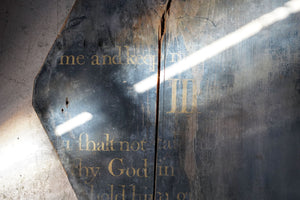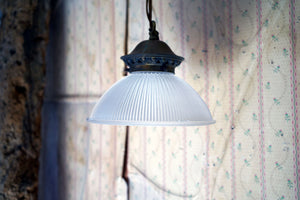Origin: American
Period: Early 20thC
Provenance: Unknown
Date: c.1920
Widths: 18”
Heights: 5.25”
Depths: 0.75” (all each)
The charming quartet of provincial stable name signs, for the horses of Yellow, Mary, Jessie and Betty, the names naively hand-painted in black to duck egg blue/grey grounds with black stained borders, surviving from the first quarter of twentieth century America.
In original overall order, the name plates show attractive time-worn, dry and un-meddled with surfaces, with losses to the stained borders on three examples as photographed. There are old, if not original, hanging hooks to each for display.
The Victorians (1837–1901) improved the lives of their horses by giving them extra comfort and hygiene, and by building more solid and robust stables, with draught free ventilation and damp free floors through drainage channels. They drew up rules on how horse stables should be built to specific specifications. From the second half of the 19th century stables were built not only for housing horses, but also for showcasing the owners’ power, wealth and pride. Horses offered transportation and they often were the most valuable asset of an estate. Stables were a true luxury and a huge amount of money was spent to buy the finest horses, bred to ride and pull carriages. Livery men were often among the best paid domestic staff, and the richest people traveled the world in search of the most beautiful breed of horses.
Equine nameplates like these rarely appear for sale, and they prove very effective as a group of folk art.
Period: Early 20thC
Provenance: Unknown
Date: c.1920
Widths: 18”
Heights: 5.25”
Depths: 0.75” (all each)
The charming quartet of provincial stable name signs, for the horses of Yellow, Mary, Jessie and Betty, the names naively hand-painted in black to duck egg blue/grey grounds with black stained borders, surviving from the first quarter of twentieth century America.
In original overall order, the name plates show attractive time-worn, dry and un-meddled with surfaces, with losses to the stained borders on three examples as photographed. There are old, if not original, hanging hooks to each for display.
The Victorians (1837–1901) improved the lives of their horses by giving them extra comfort and hygiene, and by building more solid and robust stables, with draught free ventilation and damp free floors through drainage channels. They drew up rules on how horse stables should be built to specific specifications. From the second half of the 19th century stables were built not only for housing horses, but also for showcasing the owners’ power, wealth and pride. Horses offered transportation and they often were the most valuable asset of an estate. Stables were a true luxury and a huge amount of money was spent to buy the finest horses, bred to ride and pull carriages. Livery men were often among the best paid domestic staff, and the richest people traveled the world in search of the most beautiful breed of horses.
Equine nameplates like these rarely appear for sale, and they prove very effective as a group of folk art.



























